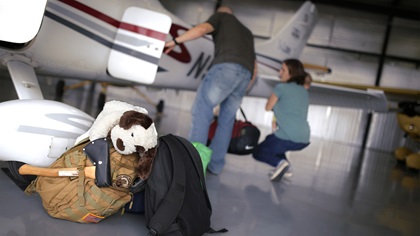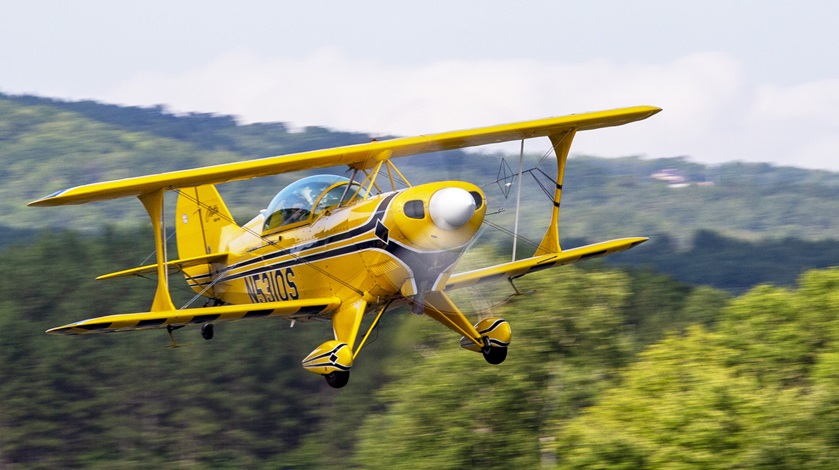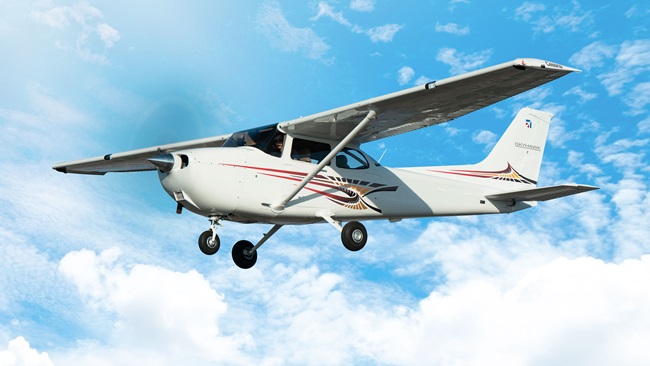Vacuum bags, bivy bags, baby wipes
The luggage limits imposed by small airplanes can be particularly cruel to pilots accustomed to creature comforts. For advice on how to make the most of the lightest load, we turned to aerobatic pilots, who can survive for weeks on the road with nothing more than what can be packed in a Pitts.
More than a few general aviation pilots have learned the joy of camping under a wing and off the grid (“flamping,” if you’re hip to the new lingo), and most GA airplanes offer at least a modest amount of luggage space, depending on how many seats are occupied, and how much fuel is in the tank. A Cessna Skyhawk can support travel for two for weeks on end without much sacrifice in terms of toiletries, and even leave room for a towel.

Available space is hard to find in aerobatic airplanes, however. A Pitts S–1 is a fine competition airplane, but there’s not much room for your stuff. Should you wish to fly one of these to Oshkosh, Wisconsin, for a week of camping at EAA AirVenture or the U.S. National Aerobatic Championships (both of which we all hope will return for 2021), the first challenge you face will be making do without the suitcase.
Several members of the International Aerobatic Club’s Chapter 35, a cluster of competitive pilots from around New England, have made the trip to the weeklong contest more than once, spending weeks living with less. While one might reasonably survey the available space in an Extra 330 SC, calculate the volume of baggage typically required for such a duration, and conclude that spending any amount of time surrounded by such pilots on the contest line would be as malodorous an experience as a hobo convention in a junkyard, that is not, in fact, the case.
“I was caught naked ‘showering’ under a garden hose in Vermont, harassed mercilessly by cows in Virginia and very nearly arrested at 1 a.m. in New Jersey,” Anderson recalled in an essay supplied by way of reply. “I can tell you that everything you’ll need for the weekend packs nicely in a single-hole Pitts.”
Anderson is a fan of the bivy (aka, a “bivvy” or “bivy sack” for a “bivouac sack”), essentially a bag made of nylon or other material that takes up far less space and weight than a tent. A compact, portable cocoon developed from military and mountaineering use, a bivy offers some degree of shelter from the elements, if not quite what some might call “comfort.”
“Reading is possible in a bivy, but little else is beyond sleep and star-gazing,” Anderson reports.
Bivies can be found in various configurations and price points. A detailed discussion of the pros and cons of each is available in this video.
Rob Dumovic, a veteran competitor, flight instructor, and IAC regional judge, makes the most of available space by compressing his clothes in Hefty vacuum bags. He advises against certain other brands that require an actual vacuum to compress their contents. A Hefty is among those that feature a one-way valve to let the air escape when the bag is squeezed by hand, but not return.
“I can get about six days’ worth of clothes in a backpack that will fit in the turtleback of an Extra,” Dumovic said in a phone chat between lessons.
Anderson’s packing list for under-wing camping includes a small bottle of concentrated body wash; personal hygiene can also be achieved, to a socially acceptable degree, when necessary, with baby wipes, prized in particular by disaster response specialists who deploy into primitive conditions where running water may not be available after a storm, just to throw that thought into the mix.

Marc Nathanson, a CFI, designated pilot examiner, aerobatic competitor, and veteran of the U.S. Air Force and FedEx, both of which called on him to live far away from home for extended periods, offered his own endorsement for Febreze fabric freshener: “Not all hotels in the different countries had laundry services,” Nathanson explained, speculating that the company CEOs’ children may have gone to college on the profits he supplied over the years.
If your itinerary takes you away from restaurants, remember freeze-dried foods pack lots of nutrition, and MSR makes camp stoves that run on avgas. They’re perfect for noodles and coffee, and with a little ductwork and ingenuity, they can also preheat your airplane’s engine on a cold winter morning.





